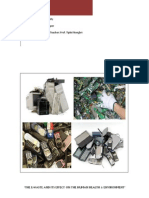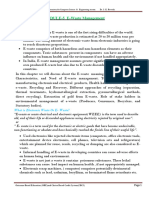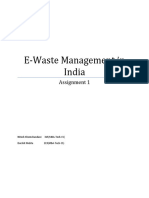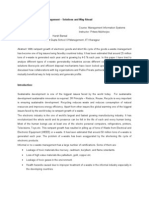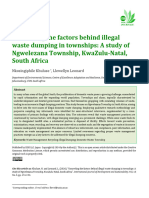bài gga về e- waste
bài gga về e- waste
Uploaded by
như huy nguyễnCopyright:
Available Formats
bài gga về e- waste
bài gga về e- waste
Uploaded by
như huy nguyễnCopyright
Available Formats
Share this document
Did you find this document useful?
Is this content inappropriate?
Copyright:
Available Formats
bài gga về e- waste
bài gga về e- waste
Uploaded by
như huy nguyễnCopyright:
Available Formats
E-Waste is the term used to describe refers to electronics such as computers, phones, radios,
refrigerators, and other devices or appliances that have been discarded. Either these products reached
the end of their functional life-cycle prior to disposal or they were simply discarded for newer models.
Recent years have witnessed a drastic increase in the amount of e-waste. This has become a pressing
problem for many countries. In this essay I will talk about e-waste that is increasingly affecting the
environment\
E-Waste contains both valuable as well as hazardous materials which require special handling and
recycling methods. It contains ferrous and non-ferrous metals, plastic, glass, wood and plywood, printed
circuit boards, concrete, ceramics, rubber and another items. Iron and steel constitute about 50% of the
waste, followed by plastic (21%), non-ferrous metal (13%) and other constituents.
Due to rapid advances in technology electronic appliances become obsolete quickly. This coupled with
explosive sales in consumer electronics, means that more products are being disposed of, even if they
still work. As an example, In the USA, about 400 million units per year of consumer electronics are
scrapped, according to recycling industry experts. Recycling e-waste is not like recycling cardboard.
These products are not easy to recycle and they are not designed for recycling.
The matter of the fact is that discarded electronics are managed badly and most e-waste still goes in the
landfill in spite of hazardous, sometimes radioactive, materials like lead, plastic, chromium, mercury,
beryllium, cadmium and acids. Moreover, all around the world, the quantity of electrical and electronic
waste generated each year has assumed alarming proportions. Thus, e-waste has become a threat to
the environment.
However, there are ways to deal with this rising issue. Effective e-waste management skills and
techniques should be developed and implemented. Producers can contribute their share of work by
taking the responsibility of e-waste management. They should reuse the parts as it would be more than
appropriate since it is already their field and it would be a profitable business for them. Making
consumers more aware of the ill-effects of improper handling and disposal would also be beneficial. In
fact, some companies are already getting a head start by placing especially dedicated e-bins.
To sum up, e-waste management has become the need of the hour. I believe that governments and
manufacturing companies should give a priority to this issue.
You might also like
- Business PlanDocument44 pagesBusiness PlanAnubhav Sood50% (2)
- E-Waste Management: Its Effect On Human Health and EnvironmentDocument19 pagesE-Waste Management: Its Effect On Human Health and EnvironmentP.K Rana100% (4)
- Essay On Electronic Waste ManagementDocument2 pagesEssay On Electronic Waste ManagementR YogaeshwerNo ratings yet
- Electronic WasteDocument3 pagesElectronic Wasteswathi0% (1)
- Electronic Waste Management in India Issues and ConcernsDocument10 pagesElectronic Waste Management in India Issues and ConcernsMohd Imran IdrisiNo ratings yet
- E Waste Management SystemDocument9 pagesE Waste Management SystemShashank Bijwe100% (1)
- E-Waste Final 2Document10 pagesE-Waste Final 2api-285382068No ratings yet
- CPT SHPDocument11 pagesCPT SHPSabeeh HussnainNo ratings yet
- Electronic WasteDocument14 pagesElectronic WastePraveen AdapaNo ratings yet
- Rajagiri College of Management and Applied SciencesDocument4 pagesRajagiri College of Management and Applied Sciencesanakaha rajeshNo ratings yet
- 1 Introduction To Electronics (E-Waste) RecyclingDocument6 pages1 Introduction To Electronics (E-Waste) RecyclingLukman Wan Mat DaudNo ratings yet
- Sangeetha DDocument38 pagesSangeetha Dsainithin070No ratings yet
- E WasteDocument25 pagesE Wastepushpzala86No ratings yet
- E Waste Mobiles ComputersDocument7 pagesE Waste Mobiles Computerschimbori85% (13)
- Ewaste Final Doc Under PreparationDocument11 pagesEwaste Final Doc Under PreparationAshay ShingornikarNo ratings yet
- Journal and Confrence Paper On (Enviornment) E - Waste ManagementDocument23 pagesJournal and Confrence Paper On (Enviornment) E - Waste ManagementsuciNo ratings yet
- E-Waste Manegement: Seminar ReportDocument27 pagesE-Waste Manegement: Seminar Reportabi6937100% (1)
- Electronics: A New Opportunity For Waste Prevention, Reuse, and RecyclingDocument4 pagesElectronics: A New Opportunity For Waste Prevention, Reuse, and RecyclingOmoloye SulaymanNo ratings yet
- Waste ManagementDocument1 pageWaste ManagementHardik ShahNo ratings yet
- Summary of Key ConceptsDocument3 pagesSummary of Key ConceptssupercleoNo ratings yet
- Introduction: E-Waste ManagementDocument12 pagesIntroduction: E-Waste ManagementAmruta PatilNo ratings yet
- Environment Law AssignmentDocument49 pagesEnvironment Law AssignmentGouri SureshNo ratings yet
- Environmental Studies EST 22427Document11 pagesEnvironmental Studies EST 22427vidyadesai1008No ratings yet
- E Waste ManagementDocument26 pagesE Waste ManagementDevesh S. TomarNo ratings yet
- e Waste Management SystemDocument9 pagese Waste Management Systemalekhya kaparthiNo ratings yet
- E-Waste Management in Indian Cities-Problems and Solutions: Anand3162@yahoo - Co.inDocument18 pagesE-Waste Management in Indian Cities-Problems and Solutions: Anand3162@yahoo - Co.inanand3162No ratings yet
- Moule 5 22ches12Document20 pagesMoule 5 22ches12Rohit RathodNo ratings yet
- E WasteDocument10 pagesE WasteVarsha RkNo ratings yet
- CC CC C CCCCCC CCC CC CCCCC CC CCCCC C CC CCCC CC CCCC C CC CC CCCC C CCC!C C CC C C " CC CCCCC !CCC C CCCCCCC #C$%C (CC CC CC C CCCC % % CCDocument5 pagesCC CC C CCCCCC CCC CC CCCCC CC CCCCC C CC CCCC CC CCCC C CC CC CCCC C CCC!C C CC C C " CC CCCCC !CCC C CCCCCCC #C$%C (CC CC CC C CCCC % % CCAman PoddarNo ratings yet
- 3 E WasteE Waste Mangeent GreenComputingDocument9 pages3 E WasteE Waste Mangeent GreenComputingkaishiwhisNo ratings yet
- E WasteDocument23 pagesE WastesreeNo ratings yet
- E - WasteDocument9 pagesE - WastemeetgoyalNo ratings yet
- Computer ScienceDocument22 pagesComputer Scienceharshpreet kaurNo ratings yet
- E-Waste Management in Bengaluru-A Recycling ApproachDocument5 pagesE-Waste Management in Bengaluru-A Recycling ApproachShilpa VishkarmaNo ratings yet
- E-Waste Management in India: Assignment 1Document14 pagesE-Waste Management in India: Assignment 1namitaguptafkNo ratings yet
- EwasteDocument1 pageEwastesunnysandeep1807No ratings yet
- E Waste Management (India) : Prepared byDocument13 pagesE Waste Management (India) : Prepared byvikrant987No ratings yet
- E-WASTE 2Document15 pagesE-WASTE 2Tresa XavierNo ratings yet
- Definitions: Electronic Waste, E-Waste, E-Scrap, or Waste Electrical and Electronic Equipment (WEEE) DescribesDocument10 pagesDefinitions: Electronic Waste, E-Waste, E-Scrap, or Waste Electrical and Electronic Equipment (WEEE) DescribesBency MathewNo ratings yet
- Em Projct....Document10 pagesEm Projct....Ruchi GoyalNo ratings yet
- E-Waste Management UPDATED.pptxDocument28 pagesE-Waste Management UPDATED.pptxmahirkachwala420No ratings yet
- Electronic Waste ManagementDocument18 pagesElectronic Waste ManagementSwetha MaheshNo ratings yet
- Electronic Waste: WARNING: Article Could Not Be Rendered - Ouputting Plain TextDocument6 pagesElectronic Waste: WARNING: Article Could Not Be Rendered - Ouputting Plain TextSunny DedhiaNo ratings yet
- Harshal Gupta EVS ProjectDocument14 pagesHarshal Gupta EVS ProjectHarshal GuptaNo ratings yet
- E Waste Case StudyDocument21 pagesE Waste Case Studyرامي أبو الفتوحNo ratings yet
- IJRPR32247Document8 pagesIJRPR32247sidhhitamhaneNo ratings yet
- E-Waste AbstractDocument2 pagesE-Waste AbstractKattela NithyasriNo ratings yet
- Gee Living in The It EraDocument8 pagesGee Living in The It EraBaguitan Krizea AbegailNo ratings yet
- E-Waste BlogDocument5 pagesE-Waste Blog23010323023No ratings yet
- E Waste ManagementDocument17 pagesE Waste ManagementAaradhya RajpalNo ratings yet
- Electronic Waste 1Document10 pagesElectronic Waste 1Kapil SvsNo ratings yet
- Reflection Paper - Death by Design Featured DocumentaryDocument1 pageReflection Paper - Death by Design Featured DocumentaryGajudo, Jorem Lois M.No ratings yet
- Electronic WasteDocument10 pagesElectronic WasteSamanthaNo ratings yet
- Welcome: in Paper Presentation On The Topic New Technology in Electronics FieldDocument16 pagesWelcome: in Paper Presentation On The Topic New Technology in Electronics FieldHuma KhanNo ratings yet
- 21EEO303T Unit IDocument42 pages21EEO303T Unit Ihaxosox413No ratings yet
- Final E-WasteDocument23 pagesFinal E-WasteSyeda TamkeenNo ratings yet
- New Microsoft Office Word DocumentDocument10 pagesNew Microsoft Office Word DocumentAkashDeep SinghNo ratings yet
- E Waste ManagementDocument12 pagesE Waste Managementharshbansal86No ratings yet
- Electronic Waste and Printed Circuit Board Recycling TechnologiesFrom EverandElectronic Waste and Printed Circuit Board Recycling TechnologiesNo ratings yet
- Ecological Effects of Electricity Generation, Storage and UseFrom EverandEcological Effects of Electricity Generation, Storage and UseNo ratings yet
- Practising Modern English For Life Sciences Students Caiet Exercitii-1Document77 pagesPractising Modern English For Life Sciences Students Caiet Exercitii-1Robert BobiaNo ratings yet
- Natural Environment EssayDocument3 pagesNatural Environment Essaymaviasultana6No ratings yet
- Exp6-Activity 3doityourself A1Document5 pagesExp6-Activity 3doityourself A1Luis fabiano Rivera canalesNo ratings yet
- Screenshot 2023-08-19 at 3.37.12 PMDocument1 pageScreenshot 2023-08-19 at 3.37.12 PMShukatoNo ratings yet
- Plastic Waste Management Assignment-Week 3: NPTEL Online Certification Courses Indian Institute of Technology KharagpurDocument16 pagesPlastic Waste Management Assignment-Week 3: NPTEL Online Certification Courses Indian Institute of Technology Kharagpuryaro oruvan0% (1)
- DPSIR FrameworkDocument15 pagesDPSIR FrameworkHalima akterNo ratings yet
- Saep 1661Document7 pagesSaep 1661Er Bishwonath ShahNo ratings yet
- Chapter Two Review LiteratureDocument21 pagesChapter Two Review LiteratureDedan GideonNo ratings yet
- EA Flora 1Document3 pagesEA Flora 1A. MagnoNo ratings yet
- Class NoteDocument8 pagesClass NoteÁnh Linh TrầnNo ratings yet
- Case Study Fact File QuestionsDocument2 pagesCase Study Fact File Questions145099No ratings yet
- What Is MarpolDocument8 pagesWhat Is Marpolkiron72No ratings yet
- Ingles 321Document2 pagesIngles 321percy hinostrozaNo ratings yet
- CHAPTER V-WPS OfficeDocument3 pagesCHAPTER V-WPS OfficeKenneth BalabaNo ratings yet
- Green MaterialsDocument27 pagesGreen MaterialsKianHe ChanNo ratings yet
- Oiv Viti 640 2020 enDocument4 pagesOiv Viti 640 2020 enJesúsNo ratings yet
- IGCSE - Bio - Lesson Plan 15 - Human Influences On The EnvironmentDocument3 pagesIGCSE - Bio - Lesson Plan 15 - Human Influences On The EnvironmentHisokagenNo ratings yet
- Material Recovery Facility PlanDocument1 pageMaterial Recovery Facility PlanEryl David BañezNo ratings yet
- Final Paper - 2024 - Unravelling The Factors Behind Illegal Waste DumpingDocument19 pagesFinal Paper - 2024 - Unravelling The Factors Behind Illegal Waste DumpingShining LightNo ratings yet
- Henwoodk Ped3120 TeacherasresearcherDocument14 pagesHenwoodk Ped3120 Teacherasresearcherapi-480914881No ratings yet
- Emissions and Health Risks From The Use of 3D Printers in An Occupational SettingDocument10 pagesEmissions and Health Risks From The Use of 3D Printers in An Occupational SettingsanswartNo ratings yet
- How America's Act in Tackling Global Issues: Food Waste ProblemDocument8 pagesHow America's Act in Tackling Global Issues: Food Waste ProblemPutri ArinaNo ratings yet
- Arciaga - Reaction PaperDocument3 pagesArciaga - Reaction PaperNina ArciagaNo ratings yet
- Ideabazz Dr. Anjali PuranikDocument12 pagesIdeabazz Dr. Anjali PuranikAnjali PuranikNo ratings yet
- 2021-06-15 SELC GASP Comments On 2021 Ambient Air Monitoring PlanDocument12 pages2021-06-15 SELC GASP Comments On 2021 Ambient Air Monitoring PlanHaley ColsonNo ratings yet
- Avpe 04Document4 pagesAvpe 04Allan vincent EyatidNo ratings yet
- Đề Thi Vào 10 - Bến TreDocument5 pagesĐề Thi Vào 10 - Bến TreMinh NguyễnNo ratings yet
- Community Action PlanDocument27 pagesCommunity Action PlanMAENo ratings yet
- Hussain Et Al., 2015Document11 pagesHussain Et Al., 2015Carlos MaroveNo ratings yet
- Env-B.Tech-VII SemDocument12 pagesEnv-B.Tech-VII SemPasunkiliNo ratings yet

